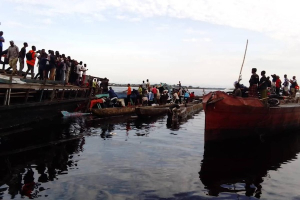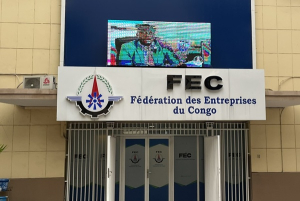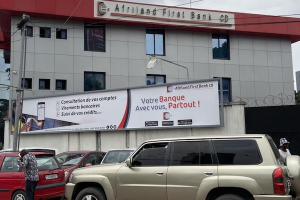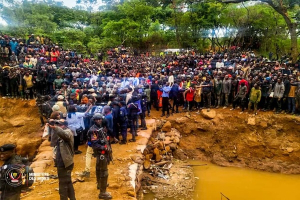Equipe Publication
DR Congo Blocks 71 Illegal River Ports, Hitting Mbandaka Supply Routes
Authorities in the Democratic Republic of Congo's Equateur province have closed 71 private ports deemed illegal in an operation launched in early November. The measure, ordered by Governor Dieudonné Bobo Boloko, is disrupting supply chains for the city of Mbandaka.
The ports were targeted for failing to meet legal requirements, including the absence of a concession title, certification of approval, or an operating license.
Among the closed ports, the Bralima port has drawn particular attention. It was long used for the arrival of food supplies from Kinshasa and from camps along the river. Local authorities have described the closure as a provisional measure, conditional on the submission of missing documents to a commission overseeing the operation.
This closure campaign fits a broader national context. In May 2025, Deputy Prime Minister and Minister of Transport Jean-Pierre Bemba circulated a list of 240 unapproved river and lake ports to be closed immediately. This was in accordance with resolutions from the 2020 Council of Ministers and presidential directives on securing river and lake navigation.
Boaz Kabeya
DR Congo Businesses Push to Delay Invoice Rule; Only 14 of 12,000 Prepared
Just days before the mandatory rollout of the standardized invoice system on December 1, 2025, the Federation of Congolese Enterprises (FEC) has requested another postponement. The request was filed with Finance Minister Doudou Fwamba after the business group raised the issue during a tax briefing held on Tuesday, November 18, in Kinshasa by the General Directorate of Taxes (DGI), according to the meeting minutes.
The FEC argues that key prerequisites for the reform are not yet in place. It cites the failure to deliver the Invoicing Control Modules (MCF), which are required to complete the approval of company invoicing systems (SFE). It also notes that the government has not published the list of approved solution providers that companies using manual invoicing need to comply with the new rules.
Thierry Ngoy Kasumba, the FEC’s Managing Director, pointed to additional issues, including platform freezes when several companies use it simultaneously, account-security vulnerabilities in case of unauthorized access, and the lack of a multi-user option, a major problem for businesses with multiple points of sale.
Given these difficulties, the FEC argues that postponing the mandatory launch is necessary to avoid disrupting business operations, especially during the end-of-year period. Data presented at the tax briefing showed that out of 12,000 taxpayers, only 14 companies had received their MCFs from the DGI to complete the approval process.
Even so, Finance Ministry officials present at the meeting upheld the December 1 date “as a reference point” for the start of the obligation to issue standardized invoices. They urged companies to use the existing support options, including information sessions and online assistance.
In a November 10, 2025 statement, the DGI said it would host free webinars on invoicing standardization from November 10 to December 19, every Monday, Wednesday, and Friday from 9 a.m. to 11 a.m. Tuesdays and Thursdays during the same period will be dedicated to training sessions on “e-UF,” a free tool that allows taxpayers without an approved invoicing system to issue standardized invoices.
The standardized invoice system is part of the government’s strategy to modernize the tax administration, track commercial transactions, secure VAT collection, curb fraud, improve the reliability of tax declarations, and boost domestic revenue.
Timothée Manoke
DR Congo Drops Afriland First Bank From Teacher Payroll After Repeated Delays
Afriland First Bank DRC is set to lose its teacher-payroll and school operating-fund contracts in five administrative areas, according to a November 14, 2025, document from the National Control Directorate (DINACOPE). The contracts will be reassigned to four other financial institutions after repeated service failures.
The portfolio being withdrawn covers 29,513 teachers, 2,039 schools, and a combined monthly volume of roughly 12 billion Congolese francs (CF) in salaries and operating costs, according to the same DINACOPE document seen by Bankable.
Under the reallocation, operations previously handled by Afriland will be transferred as follows: FirstBank will take over Gemena Ville (Sud-Ubangi); Equity BCDC will manage Idiofa (Kwilu); FINCA will handle Tshikapa 1 (Kasaï); IFOD will take Yumbi (Maï-Ndombe); and TMB will assume responsibility for Nyunzu (Tanganyika), DINACOPE said. The shift underscores operational problems that have long affected Afriland in this segment.
The decision was prompted by delays in salary payments and a series of irregularities attributed to Afriland First Bank DRC. Teachers’ unions and local elected officials in the affected areas had filed multiple complaints, criticizing the bank’s practices and urging authorities to transfer the payroll contracts to other institutions, often citing Equity BCDC, FINCA, or TMB as preferred alternatives.
Grievances had been building for months, including payment delays of up to two or three months, allegedly unlawful deductions, harassment at payment sites, selective or partial payments, inadequate facilities at payout locations, and a complete lack of standard banking services. In Idiofa (Kwilu), the teachers’ union had threatened to launch a strike on November 7, 2025, if no corrective action was taken. Separately, National Deputy Boris Mbuku Laka asked the Finance Minister in writing to move the teacher-payroll contract away from Afriland First Bank.
These developments follow a September 12, 2025, statement by Afriland First Group, which is headquartered outside the DRC, distancing itself from Afriland First Bank CD. The Congolese subsidiary has been under temporary administration since July 2021 after a decision by the Central Bank of Congo. The Group says the DRC unit is now fully managed by the government, which it accuses of trying to strip the original shareholders of their ownership. Afriland First Group says it launched proceedings in August 2023 before the International Centre for Settlement of Investment Disputes (ICSID) to challenge the government’s actions.
Timothée Manoke
Mbandaka : la fermeture de 71 ports illégaux menace l’approvisionnement
Une vaste opération lancée début novembre dans la province de l’Équateur a conduit à la fermeture de 71 ports privés jugés illégaux. Cette mesure, ordonnée par le gouverneur Dieudonné Bobo Boloko, bouleverse les circuits d’approvisionnement de la ville de Mbandaka. Ces ports ont été ciblés parce qu’ils ne remplissaient pas les conditions légales requises : absence de titre de concession, de certificat d’homologation ou encore d’agrément d’exploitation.
Parmi les ports fermés, celui de Bralima suscite une attention particulière. Longtemps utilisé pour l’arrivée de denrées alimentaires depuis Kinshasa et depuis les campements situés le long du fleuve, il est désormais à l’arrêt, ce qui devrait perturber l’approvisionnement local, le temps que les flux de marchandises se réorganisent. Les autorités locales présentent la fermeture comme une mesure conservatoire, conditionnée au dépôt des documents manquants auprès d’une commission chargée de superviser l’opération.
Cette campagne de fermeture s’inscrit dans un contexte national plus large : en mai 2025, le vice-premier ministre et ministre des Transports, Jean-Pierre Bemba, avait transmis une liste de 240 ports fluviaux et lacustres non homologués appelés à être fermés immédiatement, conformément aux résolutions des Conseils des ministres de 2020 et aux directives présidentielles sur la sécurisation de la navigation fluviale et lacustre.
Boaz Kabeya
Lire aussi :
Transport fluvial : début du balisage de 529 km sur le Kwilu, le Kwango et le Kasaï
Paie des enseignants : Afriland perd un portefeuille de 12 milliards FC par mois
Selon un document du secrétariat général de la Direction nationale de contrôle, de la préparation de la paie et de la maîtrise des effectifs (DINACOPE), daté du 14 novembre 2025, Afriland First Bank RDC perd son marché de paiement des enseignants ainsi que celui des frais de fonctionnement des établissements scolaires dans cinq entités du pays, au profit de quatre autres institutions financières. Le total du portefeuille retiré représente 29 513 agents, 2 039 établissements et un volume mensuel d’environ 12 milliards de francs congolais (masse salariale et frais de fonctionnement confondus), d’après ce même document consulté par Bankable.
Ainsi, les opérations effectuées jusque-là par Afriland à Gemena Ville (Sud-Ubangi) seront désormais assurées par FirstBank ; celles d’Idiofa (Kwilu) passent à Equity BCDC ; Tshikapa 1 (Kasaï) est transféré à FINCA ; Yumbi (Maï-Ndombe) revient à IFOD ; et Nyunzu (Tanganyika) bascule vers TMB, selon la DINACOPE. Ce basculement illustre les dysfonctionnements internes qui ont miné Afriland sur ce segment.
Cette réaffectation est motivée par des retards dans la paie et plusieurs autres irrégularités imputées à Afriland First Bank RDC. La décision intervient après une série de réclamations émanant des intersyndicales d’enseignants et des élus des différentes entités concernées. Tous dénonçaient les pratiques de cette institution financière et demandaient la délocalisation de la paie vers d’autres banques, notamment Equity BCDC, FINCA ou TMB.
Les doléances s’accumulaient en effet depuis plusieurs mois : retards de paiement allant jusqu’à deux ou trois mois, retenues jugées illégales, tracasseries lors de la paie, paiements sélectifs, manque de dispositifs suffisants dans les sites de paiement, absence totale d’avantages bancaires… Dans le territoire d’Idiofa, au Kwilu, l’intersyndicale des enseignants menaçait d’ailleurs d’observer un arrêt de travail à partir du 7 novembre 2025 si aucune solution n’était trouvée. Dans une correspondance adressée au ministre national des Finances, le député national Boris Mbuku Laka demandait explicitement la délocalisation de la paie des enseignants d’Afriland First Bank vers une autre banque.
Le 12 septembre 2025, Afriland First Group, basé hors RDC, avait publié un communiqué pour dissocier son image de celle d’Afriland First Bank CD, placée sous gouvernance provisoire depuis juillet 2021 à la suite d’une décision de la Banque centrale du Congo. Le groupe affirme que la filiale en RDC est désormais entièrement gérée par le gouvernement congolais, qu’il accuse de vouloir « déposséder » les actionnaires d’origine. Face à cette situation, Afriland First Group dit avoir engagé, depuis août 2023, une procédure devant le Centre international pour le règlement des différends relatifs aux investissements (CIRDI) afin de contester les mesures prises par l’État congolais.
Timothée Manoke
Lire aussi :
Paiement des agents publics : Equity BCDC grapille des parts de marché à Afriland
Facture normalisée : la FEC sollicite un nouveau report de la phase obligatoire
A quelques jours du 1er décembre 2025, date retenue pour le lancement de la phase obligatoire de la facture normalisée en République démocratique du Congo (RDC), la Fédération des entreprises du Congo (FEC) affirme avoir saisi le ministre des Finances, Doudou Fwamba, pour solliciter un nouveau report. Elle avait déjà formulé cette demande lors de la matinée fiscale organisée le mardi 18 novembre à Kinshasa par la Direction générale des impôts (DGI), apprend-on du compte rendu de cette réunion.
Pour l’organisation patronale, les préalables nécessaires à la mise en œuvre de cette réforme ne sont toujours pas réunis. Elle évoque notamment la non-remise des modules de contrôle de facturation (MCF), indispensables à la finalisation de la procédure d’homologation des systèmes de facturation d’entreprise (SFE), ainsi que l’absence de publication de la liste des fournisseurs agréés de solutions, censée permettre aux entreprises utilisant encore la facturation manuelle de se conformer aux nouvelles exigences.
L’administrateur délégué de la FEC, Thierry Ngoy Kasumba, pointe également d’autres difficultés : blocage de la plateforme lorsque plusieurs entreprises l’utilisent simultanément, failles de sécurité des comptes en cas d’accès non autorisé, absence de système multiutilisateurs pénalisant les sociétés disposant de plusieurs points de vente, etc.
Face à ces défis, la FEC estime qu’un report de la date de lancement de la phase obligatoire est nécessaire pour garantir la fluidité des activités commerciales, particulièrement en période de fêtes de fin d’année. Selon les statistiques communiquées lors de la matinée fiscale, sur 12 000 assujettis, seules 14 entreprises avaient obtenu les MCF auprès de la DGI pour finaliser la procédure d’homologation.
Malgré cette situation, les responsables du ministère des Finances présents à la rencontre ont maintenu la date du 1er décembre « comme un repère (référence) » pour le début de l’obligation d’émission et de délivrance des factures normalisées. Ils ont plutôt encouragé les entreprises à s’appuyer sur les mécanismes d’accompagnement existants, notamment les sessions d’information et l’assistance en ligne.
Dans un communiqué daté du 10 novembre 2025, la DGI a notamment annoncé l’organisation de webinaires gratuits sur la généralisation de la facture normalisée, programmés du 10 novembre au 19 décembre 2025 chaque lundi, mercredi et vendredi de 9 h à 11 h. Les mardis et jeudis de la même période sont réservés à des sessions de formation sur l’utilisation de « e-UF », un dispositif gratuit permettant aux assujettis n’ayant pas encore obtenu l’homologation de leur système de facturation d’émettre malgré tout des factures normalisées.
La facture normalisée s’inscrit dans la stratégie de modernisation du système fiscal congolais. Elle vise à tracer les transactions commerciales, sécuriser la collecte de la TVA, réduire la fraude, fiabiliser les déclarations fiscales et accroître les recettes internes.
Timothée Manoke
Lire aussi :
Facture normalisée : nouveau moratoire sur une réforme clé de la TVA en RDC
DRC Seeks Partners for National Rail Factory
The Democratic Republic of Congo has issued an international call for expressions of interest to build a national rail manufacturing plant, the transport ministry said.
The initiative builds on a project unveiled in October 2025 to establish train assembly and manufacturing plants in Matadi and Kalemie, aimed at producing several dozen locomotives and wagons a year and training local engineers and technicians.
The rail plant project covers three sites: Kisangani, Kinshasa and Banalia. The main facility in Kisangani will house hot rolling mills for producing UIC54 and UIC60 rails. Kinshasa will handle machining, quality control and storage for export and western transport corridors.
The Banalia site, in Tshopo province, will focus on extracting and processing raw materials such as iron ore, limestone, and coking coal. The wider complex will include electric arc furnaces, metallurgical laboratories, test benches, a hybrid hydro-solar power plant, and an industrial training centre.
The proposed structure is a Build-Own-Operate-Transfer public-private partnership or an industrial joint venture. It would bring together the Congolese state, specialised industrial partners, and international investors, including the African Development Bank, the European Investment Bank, the World Bank, Afreximbank, TDB, and Eximbank.
A special-purpose vehicle will oversee the design, financing, construction, and operation of the infrastructure.
Applications must be submitted by March 9, 2026. Required documents include a letter of interest, a detailed consortium description, legal and administrative paperwork, technical references, financial statements for the past three years, and a concept paper outlining the technical approach, the PPP financing model, the technology transfer plan, and the implementation schedule.
Boaz Kabeya
DRC Creates 64+ Legal Mining Zones After Deadly Kalando Accident
The Democratic Republic of Congo's mines minister announced the creation of 64 artisanal mining zones on Monday, Nov. 17.
The announcement was made during a crisis meeting in Kolwezi, held two days after a November 15 accident at the Kalando mine that killed around 40 artisanal miners.
"I can officially tell you today that at least 64 artisanal mining zones have been cleared for you," Mines Minister Louis Watum Kabamba said.
Identifying these zones was the first part of a plan presented by President Felix Tshisekedi during a June 13 council of ministers meeting to curb "the perverse effects denounced in artisanal mining" in Lualaba province, as soon as possible."
Among the problems identified by the head of state was the invasion of industrial mining concessions by artisanal miners, generating cohabitation tensions. The Kalando site is one example. Located 42 kilometers southeast of Kolwezi, it sits on a permit (PE 2116) belonging to Chemical of Africa (Chemaf), which said it ceded the permit to Pajeclem Congo Consulting Sarl on July 21. Artisanal miners access it only on weekends under a "social" authorization, a situation conducive to tension.
President Tshisekedi had requested that the identified zones be "likely to meet the expectations of the sector." The ministry said the 64 zones were determined following joint work with specialized services and validated after several technical field missions.
Minister Watum Kabamba said the decrees establishing these zones have already been signed. It is not yet known when the sites will be made available or when work can begin.
State cobalt monopoly central to formalization plan
Mining in the zones is expected to be conducted in collaboration with the state-owned Entreprise Générale du Cobalt (EGC), a subsidiary of Gécamines, which holds a monopoly on trading artisanal production of strategic minerals like cobalt.
EGC said it has implemented a model to align the artisanal sector with international standards to facilitate the commercialization of its production. The model relies on deploying "controlled mining areas, equipped with weighing devices, direct payment mechanisms and digital tracking systems, guaranteeing that each ton is traceable from the artisanal site to the processing plant."
To allow EGC to exercise its monopoly fully, President Tshisekedi has demanded the strict application of all rules, including sanctions, against processing plants and entities that illegally purchase artisanal cobalt, bypassing EGC's legal monopoly. He also called on Gécamines and its subsidiary to strengthen their financial collaboration. EGC needs funding to offer artisanal miners competitive prices and cash payments to capture a significant share of production.
In a bid to attract investors, EGC presented its first production of 1,000 tons of what it called "structured, ethical and traceable" artisanal cobalt in Kolwezi. Despite the recent accident, artisanal activity continues at Kalando "to maintain social stability.”
Pierre Mokoko & Ronsard Luabeya
Chemin de fer : la RDC veut créer une usine de fabrication de rails
La République démocratique du Congo (RDC) a lancé un appel à manifestation d’intérêt international (AMI) pour la création d’une usine nationale de fabrication de rails ferroviaires. L’annonce a été faite par le ministère des Transports, des Voies de communication et du Désenclavement, sous la signature du vice-Premier ministre et ministre des Transports, Jean-Pierre Bemba.
Cette initiative complète le projet dévoilé en octobre 2025 visant la création d’unités d’assemblage et de montage de trains à Matadi et Kalemie, capables de produire plusieurs dizaines de locomotives et de wagons par an, tout en formant des ingénieurs et techniciens locaux.
Le projet prévoit trois sites : Kisangani, Kinshasa et Banalia. À Kisangani, l’unité principale sera équipée de laminoirs à chaud pour la production de rails UIC54 et UIC60. Kinshasa accueillera les opérations d’usinage, de contrôle qualité et de stockage logistique pour l’exportation et les corridors de l’Ouest. Banalia, dans la province de la Tshopo, sera dédiée à l’extraction et au traitement des matières premières telles que le minerai de fer, le calcaire et le charbon métallurgique. L’ensemble comprendra des fours électriques à arc, des laboratoires métallurgiques, des bancs d’essai, une centrale énergétique hybride hydro-solaire et un centre de formation industrielle.
Le Gouvernement de la République démocratique du Congo, à travers son Ministère des Transports, Voies de communication et Désenclavement, lance un Appel à Manifestation d’Intérêt International (AMI) afin d’identifier et de présélectionner des partenaires techniques, industriels… pic.twitter.com/3QDQl2Aqf9
— Ministère des Transports RDC (@TransportsRDC) November 20, 2025
Le montage institutionnel envisagé repose sur un partenariat public-privé (PPP) de type Build-Own-Operate-Transfer (BOOT) ou une joint-venture industrielle, impliquant l’État congolais, des partenaires industriels spécialisés et des investisseurs internationaux tels que la BAD, la BEI, la Banque Mondiale, Afreximbank, TDB et Eximbank. Une société de projet (SPV) sera chargée de la conception, du financement, de la construction et de l’exploitation de l’infrastructure.
L’annonce précise que les dossiers de candidature doivent être déposés avant le 9 mars 2026 et comprendre une lettre d’intérêt, la présentation détaillée du consortium, les documents juridiques et administratifs, les références techniques, les états financiers des trois dernières années, ainsi qu’une note conceptuelle exposant l’approche technique, le modèle de financement en PPP, le plan de transfert de technologie et le calendrier de mise en œuvre.
Boaz Kabeya
Lire aussi :
Transport ferroviaire : un appel à partenaires pour bâtir une industrie du rail en RDC
DRC launches rehabilitation of 280 km of rural roads in Mai-Ndombe
The National Road Maintenance Fund (FONER) launched on November 20, 2025, in Inongo, the capital of Mai-Ndombe province, a road maintenance program covering the rehabilitation of 280 kilometers of roads. The governor, Lebon Nkoso, officially opened the project, which aims to improve internal connectivity and support economic activity.
The program spans seven of the province’s eight territories: Yumbi, Kiri, Mushie, Kutu, Inongo, Oshwe, and Bolobo. Only Kwamouth is excluded due to ongoing insecurity.
Several priority sections have been selected, including Bolobo–Ngemu (30 km), Boulevard Ngobila–Yanzalinga (10 km), Banzomoke–Ponde (35 km), Modeo–Nkondi (30 km in Kiri), and Kutu Panza 3–Itwa (35 km in Kutu), among others.
Execution of the works has been entrusted to the Office des voies de desserte agricole (OVDA) for a three-month period. According to provincial director Deo Gratias Ngontula, monthly assessments will be conducted to monitor progress and quality.
Governor Lebon Nkoso noted that this program is a key development tool for the province. He called for rigorous implementation to ease the movement of goods and people across the region.
In addition, two territories in Mai-Ndombe are part of another program covering 103 kilometers of agricultural roads leading to major production areas, identified last July by the Social Fund of the Republic. Their rehabilitation, also assigned to OVDA under the Value Chain Development Support Project, includes the construction of four bridges and three small port facilities, two in Inongo and one in Bokoro.














